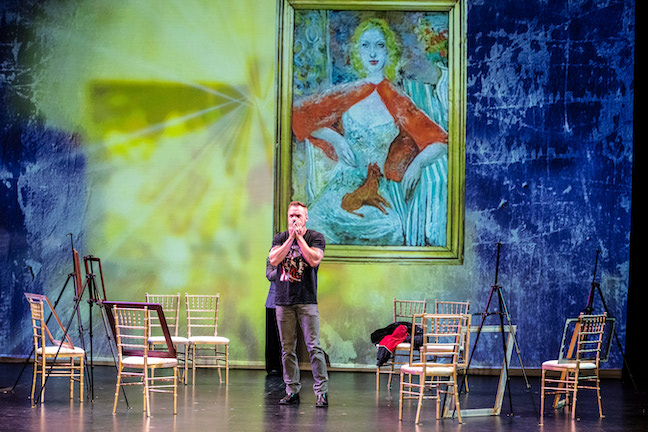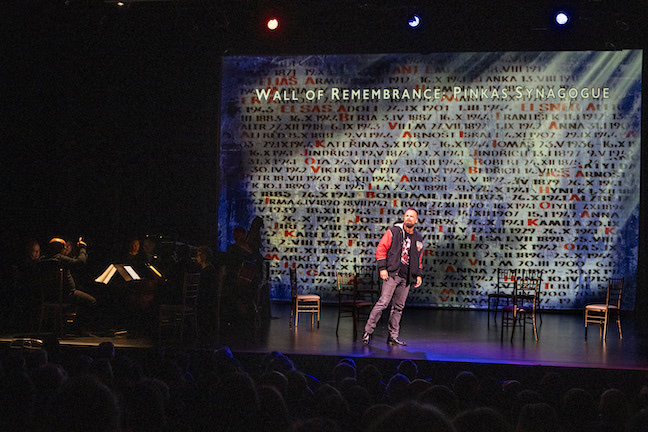
On May 25th and 26th, Music of Remembrance, an artistic endeavor dedicated to creating and presenting art inspired by or related to survivors of The Holocaust, in collaboration with Chicago Opera Theater concluded a 3-city tour celebrating its 25th anniversary presenting Before It All Goes Dark, a new opera by Jake Heggie and Gene Scheer at the Studebaker Theater, 410 S. Michigan, Chicago.
This was a 3-part performance; a talk with Artistic Director Mina Miller, librettist Scheer, and Howard Reich, the author of the story behind the story; a chamber music concert set in the imagined salon of an art collector murdered in The Holocaust; and a one-act opera memorializing a fascinating though ultra tragic story that began and ended in Czechoslovakia, coming to and culminating in the Chicagoland area.
From the discussion we learn: 100 years ago in Prague, there once was a father and great-great-uncle named Dr. Emil Freund, a Jewish lawyer/insurance executive and art collector. He and his immediate family perished in the Lodz ghetto and concentration camps. But their art collection, some 30 + Impressionist, Pointillist, Cubist and other works of color and culture lived on- the Nazis were expert art confiscators. A non-linear part of the family escaped and fled to Chicago, and their line was almost extinct at The Millenium. One descendant, a Vietnam veteran minus a Jewish identity, was Freund’s next survivor. This remnant of the family, Gerald “Mac” McDonald, who didn’t even know he was Jewish, was extremely ill and failing when he came under the aegis of 2d generation Holocaust survivor Howard Reich, musically trained and a lauded journalist.
The wonderful chamber music concert conducted by Joseph Mechavich is comprised of the music of Robert Dauber, David Beigelman, and Erwin Schulhoff. Beigelman, like Freund, was moved into the Lodz ghetto, which became a slave labor camp. He took an active part in its cultural life, composing orchestral works and songs, one lovely example, Makh Tsu Di Eygelekh, was presented. The only composition of Daubers that has been preserved, A Serenade for violin and piano, was lyrically beautiful; he died in Dachau. 4 works by Schulhoff, all very different, joyous and young-hearted, were included; his career, too, was prematurely terminated by the rise of the Nazi regime in Germany, and unfortunately, his fine works have been rarely noted or performed.

Kudos to Demarre McGill, flute; Laura DeLuca, clarinet; Mikhail Shmidt, violin; Susan Gulkis Assadi, viola; Eric Han, cello; Jonathan Green, double bass and Jessica Choe, piano, The Music of Remembrance Ensemble.
The opera’s story begins after Reich has connected McDonald with the art, being held in The Jewish Museum in Prague. We learn that they travelled together to The Czech Republic, although Reich himself is not in the opera. McDonald who knows virtually nothing about visual art, let alone art history, is completely mesmerized by the collection, and here is where Peter Crompton’s inspired projections really shine. The paintings seem to shimmer and enter the theater itself as they enlarge and emanate out from their backdrop one by one: a Vlaminck, an Utrillo, a Zykmund, a Filla. It’s a very moving scene as bass-baritone Ryan McKinny is advised by mezzo-soprano Megan Marino, as museum curator, informs Mac that the Czech Republic has decreed Freund’s collection to be historical treasures that cannot be taken out of the country.
There has been a lot of attention paid, many books written, recent movies filmed about Holocaust era art looting and its restitution. Indeed, the notion of stolen great art has become a sub-genre of mystery books/police procedurals, even a Pulitzer prize-winning novel, The Goldfinch. Similarly, there are a huge number of recent and not-so-recent books on the inheritance- spiritual and temporal- of Holocaust survivors. But this opera is special in that it turns the story itself into artwork. With an inclusive concert of Holocaust-era music and projections that illuminate the audience with the power of art to transform, it lifts the performance out of the tragic history and gifts us with the lasting treasury of the paintings themselves.

The talk before the performance is fascinating and demonstrates how Reich’s life has been influenced not just by art but by the enormous impact The Shoa has had on his life and by him on other lives; even before he wrote “Mac’s Story”, he embarked on a family quest to Czechoslovakia to find his mother’s family- he has embodied the quest of Music of Remembrance. The chamber music concert, consisting of pieces by 3 composers who died in concentration camps is remarkably moving, the opera is beautifully sung in English, and the whole leaves us with a sense of cosmic significance: the power of art to transform individual lives and all of society.
All photos by Terry Lorant
For information about Music of Remembrance, the opera, and their published music, go to www.musicofremembrance.org

Be the first to comment